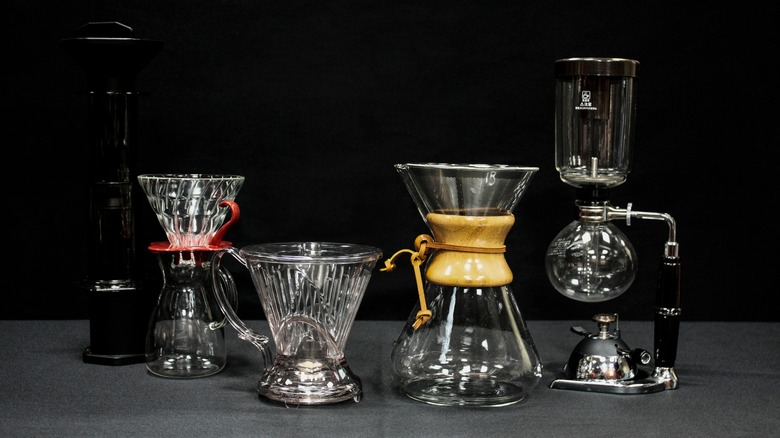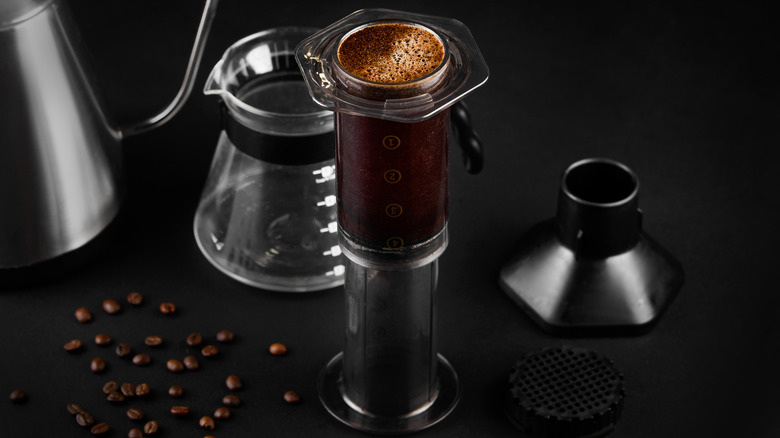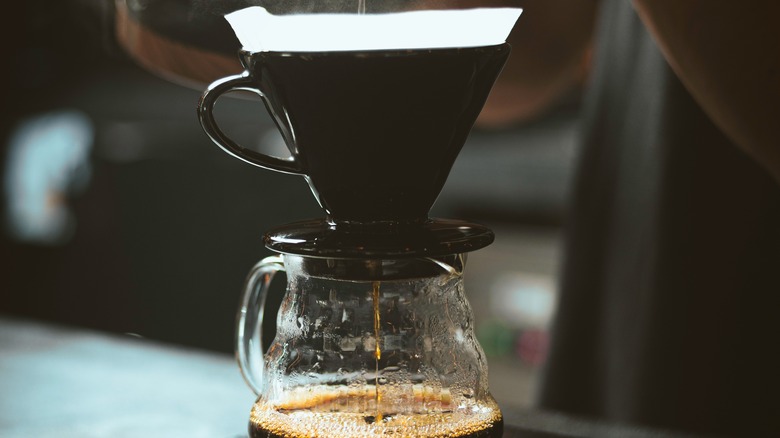The Difference Between Aeropress And V60 Coffee Makers
From baristas to brewmasters and roasters, we enjoy front-row coffee-shop views of these experts, creating perfect brews in our cups. But there's another behind-the-scenes group of java techs and scientists constantly inventing or improving how that liquid gets extracted from the beans. The subtleties of each coffee machine, described by Mako Design + Invent, define the warm deliciousness sliding down your throat, whether it's from a drip, stovetop, pour-over, cold brew, percolator, espresso machine, pod-style pump machine, or other variations slipping into the paraphernalia parade.
Two drum majors in the java band are the AeroPress and V60 coffee makers. Despite similarities, they each play distinct roles in the world of coffee creation and consumption. Fortunately, the techniques involved in mastering these machines are perfectly suited to home brewing techniques. In other words, yes, you can easily operate these coffee makers in your kitchen or home-based espresso bar.
Both the AeroPress and V60 coffee makers are manual extractors, ceding to you the ultimate control over your "cuppa Joe." Compared to automatic or semi-automatic machines, you can customize the brew according to your preferences for strength and flavor intensity, explains KitchenAid. This mostly comes down to infusion timing and pressure regulation. If you're willing to put in a bit of time, especially when making a single cup, the AeroPress and V60 makers deserve consideration. Here's a look at the two java-extracting cousins and how they diverge in composition and user approach.
Aeropress uses a plunge-and-press method
AeroPress enters the coffee industry courtesy of inventor Alan Adler, who has accumulated more than 40 patents in his lifetime thus far, according to AeroPress. It combines drip and press techniques rather than the drip-only method employed by a V60. In both, the size of the bean grind makes a big difference. The company's brew basics explain that a course grind increases the flow rate to about two times faster than a medium grind. The larger the grounds, the weaker the strength of the coffee. Per Coffee Tea Warehouse, a finer grind gives the strongest cup of coffee, preferable for those who crave espresso-style brews.
An AeroPress chamber bears a cylindrical shape, to which you add a filtered cap and place it atop a sturdy mug (via AeroPress instructions). Add about a tablespoon of ground beans, pour hot water at 175 F over them, and stir for about 10 seconds (or longer per taste). Then, insert the provided plunger and slowly press the liquid into the cup.
The AeroPress coffee maker also facilitates cold brews, and you can create all the coffee styles you love, including lattes, espressos, Americanos, and pretty much anything else. According to the New York Times, the main advantage to an AeroPress is that you get an easy, quick, high-quality brew that compares favorably to a coveted pour-over coffee. It's available in a compact travel size as well.
V60 uses a funnel with a filter
The V60 has its share of java fans, especially those looking for an upgrade on the standard electric drip coffeemaker. While the typical push-a-button drip machine works well for busy mornings or fueling a group of on-the-go commuters, it's a one-size-fits-all approach. And the taste reflects that. The V60 instead provides bright, clear flavors and aromas, highlighting nuances of the coffee's taste, per North Star Coffee Roasters.
This coffee maker differs from AeroPress in that it allows a natural drip rather than creating a press/plunge extraction. It also bears a conical shape and uses disposable paper filters. Pact Coffee states that the paper absorbs inherent oils in the beans, leaving a lighter, cleaner taste. Most V60 funnels come with interior ribs that spiral downward, providing space for the coffee to bubble and "bloom," which indicates how fresh the beans are.
To operate, place the cone-shaped funnel over your chosen glass, ceramic, or stainless steel container that's appropriate for hot drinks. Using a provided scoop, drop freshly ground beans into a paper filter, then add water that's boiled for at least 60 seconds, per Pact Coffee. But don't just do a quick water dump — pour it in circles to soak all the grounds, and then retrace your pour backward. This way, you saturate the beans more evenly to carry more flavor into your cup. A bonus is its easy cleanup; just toss the paper filter and rinse the container.


